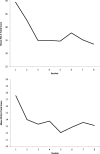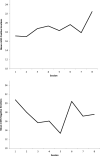Compassion Meditation for Veterans with Posttraumatic Stress Disorder (PTSD): a Nonrandomized Study
- PMID: 32435316
- PMCID: PMC7223870
- DOI: 10.1007/s12671-017-0866-z
Compassion Meditation for Veterans with Posttraumatic Stress Disorder (PTSD): a Nonrandomized Study
Abstract
Compassion meditation (CM) is a contemplative practice that is intended to cultivate the ability to extend and sustain compassion toward self and others. Although research documents the benefits of CM in healthy populations, its use in the context of psychopathology is largely unexamined. The purpose of this study was to refine and initially evaluate a CM protocol, Cognitively Based Compassion Training (CBCT®), for use with Veterans with PTSD. To this end, our research team developed and refined a manualized protocol, CBCT-Vet, over 4 sets of groups involving 36 Veterans. This protocol was delivered in 8-10 sessions, each lasting 90-120 min and led by a CBCT®-trained clinical psychologist. Quantitative and qualitative data were used to identify areas to be improved and to assess change that occurred during the treatment period. Based on pooled data from this series of groups, CM appears to be acceptable to Veterans with PTSD. Group participation was associated with reduced symptoms of PTSD (partial eta squared = .27) and depression (partial eta squared = .19), but causality should not be inferred given the nonrandomized design. No change was observed in additional outcomes, including positive emotion and social connectedness. The results of this open trial support additional exploration of CM as part of the recovery process for Veterans with PTSD.
Keywords: Compassion; Meditation; Mindfulness; PTSD.
© US Government (outside the USA) 2017.
Conflict of interest statement
Conflict of InterestDrs. Lang, Casmar, Hurst, Golshan and Essex and Ms. Good declare no conflict of interest. Dr. Negi and Mr. Harrison have a copyright for CBCT®.
Figures



Similar articles
-
Compassion Meditation for Posttraumatic Stress Disorder in Veterans: A Randomized Proof of Concept Study.J Trauma Stress. 2019 Apr;32(2):299-309. doi: 10.1002/jts.22397. Epub 2019 Mar 31. J Trauma Stress. 2019. PMID: 30929283 Clinical Trial.
-
Loving-kindness meditation for posttraumatic stress disorder: a pilot study.J Trauma Stress. 2013 Aug;26(4):426-34. doi: 10.1002/jts.21832. Epub 2013 Jul 25. J Trauma Stress. 2013. PMID: 23893519 Clinical Trial.
-
Cognitively-Based Compassion Training versus cancer health education to improve health-related quality of life in survivors of solid tumor cancers and their informal caregivers: study protocol for a randomized controlled pilot trial.Trials. 2019 Apr 29;20(1):247. doi: 10.1186/s13063-019-3320-9. Trials. 2019. PMID: 31036091 Free PMC article.
-
Efficacy of Meditation-Based Interventions on Post-Traumatic Stress Disorder (PTSD) Among Veterans: A Narrative Review.Adv Mind Body Med. 2021 Winter;35(1):16-24. Adv Mind Body Med. 2021. PMID: 33513582 Review.
-
The theoretical and empirical basis for meditation as an intervention for PTSD.Behav Modif. 2012 Nov;36(6):759-86. doi: 10.1177/0145445512441200. Epub 2012 Jun 5. Behav Modif. 2012. PMID: 22669968 Review.
Cited by
-
Loving-Kindness Meditation: Systematic Review of Neuroimaging Correlates in Long-Term Practitioners and Clinical Implications.Brain Behav. 2025 Mar;15(3):e70372. doi: 10.1002/brb3.70372. Brain Behav. 2025. PMID: 40022190 Free PMC article.
-
The promise of compassion-based therapy as a novel intervention for adolescent PTSD.J Affect Disord Rep. 2024 Jan;15:100694. doi: 10.1016/j.jadr.2023.100694. Epub 2023 Dec 3. J Affect Disord Rep. 2024. PMID: 38283688 Free PMC article.
-
Investigating the Influence of Self-Compassion-Focused Interventions on Posttraumatic Stress: A Systematic Review and Meta-Analysis.Mindfulness (N Y). 2021;12(12):2865-2876. doi: 10.1007/s12671-021-01732-3. Epub 2021 Sep 24. Mindfulness (N Y). 2021. PMID: 34584575 Free PMC article. Review.
-
Effectiveness of Meditation Techniques in Treating Post-Traumatic Stress Disorder: A Systematic Review and Meta-Analysis.Medicina (Kaunas). 2024 Dec 12;60(12):2050. doi: 10.3390/medicina60122050. Medicina (Kaunas). 2024. PMID: 39768929 Free PMC article.
-
Prevalence of Mental Health Problems and Willingness to Participate in a Mindfulness Treatment: An Examination among Veterans Injured in Combat.Mindfulness (N Y). 2019 May;10(5):953-963. doi: 10.1007/s12671-018-1047-4. Epub 2018 Nov 10. Mindfulness (N Y). 2019. PMID: 31131067 Free PMC article.
References
-
- American Psychiatric Association . Diagnostic and statistical manual of mental disorders. 5. Washington DC: American Psychiatric Publishing; 2013.
-
- Attkisson CC, Greenfield TK. Client satisfaction questionnaire—8 and service satisfaction scale—30. In: Maruish ME, editor. The use of psychological testing for treatment planning and outcome assessment. Hillsdale: Lawrence Erlbaum Associates; 1994.
-
- Borkovec TD, Nau SD. Credibility of analogue therapy rationales. Journal of Behavior Therapy and Experimental Psychiatry. 1972;3:257–260. doi: 10.1016/0005-7916(72)90045-6. - DOI
